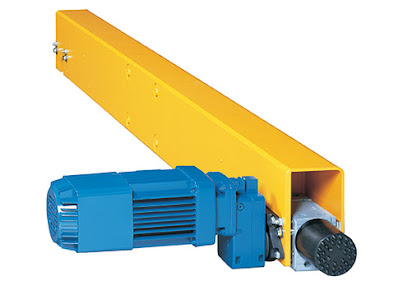As industries worldwide strive to reduce their environmental impact, sustainability has become a key focus across various sectors. Material handling, a crucial part of industrial operations, is no exception. Overhead cranes, which are commonly used for lifting, moving, and positioning heavy materials, are playing an essential role in improving sustainability within manufacturing, warehousing, and distribution processes.
Overhead cranes are an integral part of many industries, from construction and
manufacturing to shipping and logistics. These cranes provide a means of
transporting large, heavy materials efficiently and safely. However, as
industries seek to optimize their operations to reduce energy consumption,
carbon emissions, and waste, the question arises: How can overhead cranes
contribute to sustainable material handling?
1. Energy Efficiency
One of the most significant ways overhead
cranes contribute to sustainability is through energy efficiency. In
traditional material handling systems, like forklifts and conveyors, energy
consumption is often higher due to the need for constant operation and the use
of fossil fuels. In contrast, modern overhead cranes are designed with
energy-saving features that make them more environmentally friendly.
For instance, electric overhead cranes use
advanced electric motors and drives that consume significantly less energy than
their diesel or gas-powered counterparts. Many of these cranes also come
equipped with regenerative braking systems, which capture and store the energy
generated during braking. This stored energy can then be used to power the
crane’s next lift, further reducing overall energy consumption and contributing
to sustainability.
2. Optimized Use of Space and Resources
In addition to being energy-efficient,
overhead cranes help optimize the use of space within industrial facilities.
This is especially important in warehouses and manufacturing plants where space
is often limited and valuable. Overhead cranes utilize vertical space, allowing
companies to store and retrieve materials at higher levels rather than
spreading them across the floor. This efficient use of space reduces the need
for additional storage structures, minimizing construction waste and the
environmental impact of building new facilities.
Moreover, by enhancing storage efficiency,
overhead cranes can also reduce the frequency of material handling operations,
cutting down on the time spent moving goods. Fewer movements result in less
energy usage and less wear and tear on equipment, contributing to a more
sustainable overall operation.
3. Longer Lifespan and Reduced Waste
Another significant sustainability benefit
of overhead cranes is their durability and longevity. These cranes are designed
to handle heavy loads and withstand demanding environments, making them less
prone to breakdowns and the need for frequent repairs or replacements. As a
result, the lifespan of an overhead crane is often much longer than other types
of material handling equipment.
This extended lifespan directly impacts
sustainability by reducing the need for constant manufacturing and disposal of
new equipment. Additionally, the materials used to construct overhead cranes,
such as high-strength steel and durable components, are typically recyclable.
This reduces the overall environmental impact, contributing to a more
sustainable lifecycle.
4. Reduced Carbon Footprint
Overhead cranes also help reduce the carbon
footprint of industrial operations. By improving the efficiency of material
handling processes, reducing energy consumption, and optimizing space, these
cranes indirectly contribute to lower greenhouse gas emissions. Fewer forklifts
and other transport vehicles on the floor mean less fuel consumption and lower
emissions of harmful gases, such as CO2 and nitrogen oxides.
Furthermore, by reducing the number of
on-site movements and increasing the speed and accuracy of material handling,
overhead cranes contribute to streamlined operations that require less
transportation and, therefore, less energy. This helps industries meet their
carbon reduction goals, which are increasingly important as global regulations
on emissions tighten.
5. Minimizing Human Error and Enhancing
Safety
Sustainable material handling also involves
improving safety and reducing accidents. Overhead cranes enhance workplace
safety by reducing the need for manual labor and minimizing the risk of injury
to workers. By automating the lifting and movement of heavy loads, overhead
cranes decrease the likelihood of accidents such as musculoskeletal injuries,
falls, and collisions. With safer work environments, the risk of damage to
materials is also reduced, preventing material wastage.
Additionally, many modern overhead cranes
come equipped with advanced control systems that improve precision and accuracy
during lifts. This reduces the likelihood of errors that could result in damage
to goods or the crane itself, which would otherwise lead to resource wastage
and the need for repairs.
6. Support for Lean Manufacturing
Principles
Overhead cranes play an essential role in
lean manufacturing, a production strategy that emphasizes minimizing waste,
maximizing value, and improving efficiency. By providing a safe and efficient
means of moving materials, these cranes support lean principles by reducing
material handling time and streamlining operations. Lean manufacturing aims to
eliminate waste in all forms, including excessive transportation, waiting, and
inventory. Overhead cranes contribute by reducing unnecessary movement and
improving the flow of materials, directly aligning with the goals of lean
manufacturing.
Conclusion
Overhead cranes are not just essential for
improving operational efficiency—they also play a significant role in making
material handling more sustainable. Through energy efficiency, optimized use of
space, extended lifespan, reduced carbon footprint, and support for lean
manufacturing, overhead cranes contribute to a more sustainable industrial
operation. As industries continue to prioritize environmental responsibility,
these cranes will undoubtedly remain a key component of sustainable material
handling solutions, helping companies meet their sustainability goals while
maintaining productivity.










